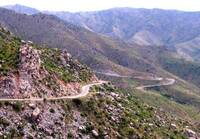- England
- Scotland
- France
- Holland
- Germany
- Italy
- Spain
- Portugal
- USA
- China
- Japan
- India
- Iran
- Advice
- Gardens
- England
- Scotland
- France
- Holland
- Germany
- Italy
- Spain
- Portugal
- USA
- China
- Japan
- India
- Iran
- Advice
- Garden Tours
Book: Landscape Planning and Environmental Impact Design: from EIA to EID
Chapter: Chapter 10 Sustainable green transport
Roads are highly significant landscape features. Geometrical design criteria, and design speeds, may need to change in mountainous country. Fence and wall details should normally be characteristic of the area through which the road passes. Bank profiles, soil and vegetation characteristics should reflect those of the locality. If the road is to be Different from its context, then, as discussed in Chapter 3, a well-argued case must be prepared and presented to the planning or environmental authority. An Identity Index should be specified and calculated for each section of the route. EID is necessary. The techniques for establishing vegetation on the margins of new roads was for too long regarded as a branch of agriculture. It is now coming to be seen as a branch of nature conservation. A landscape manager, in noting that it will take time to discover how best to manage ecosystems for amenity, writes that: In the meantime, if the amenity land manager is ever in doubt as to his best course of action, he has merely to think of what a modern farmer or forester would do, and do the opposite. His objective is to make one blade of grass grow where two grew before (Green, 1986). Modern roads render the land over which they pass impervious to water. It is collected in drains and discharged into streams, rivers, soakaways or specially constructed storm detention basins. Regrettably, the water is not clean when it has run off a vehicular surface. It is polluted by hydrocarbons and heavy metals. But this is no excuse for the ugliness of detention basins [Fig 10.10]. Instead of being standard products, they should relate to local climatic, geological and hydrological conditions. Filtration can remove pollutants. Road alignments should relate to contexts. Modern roads fit most comfortably into the landscape when the relief undulates gently [Fig 10.11]. The 'flowing alignment' (McLusky 1979: 9), which is preferred by engineers, fits with flowing contours. Approaches to dealing with the visual problems which arise are dealt with in the Good roads guide (Department of Transport, 1992). The flowing alignment is much less successful in mountains, flat land and urban areas. British mountains are not high, and the expansive scale of the flowing alignment tends to erode landscape character. This is especially apparent in the Lake District, which merits a historicist approach to highway design. In urban areas the flowing alignment is often disastrous: it breaks the continuity of the urban fabric and converts towns into suburbs. It would be better to adopt a creative approach.


